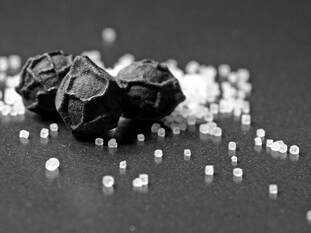
Maldon salt, incidentally, has a very long history. Humans have been harvesting salt there for thousands of years, even before recorded history. The spring tides come in over the seagrass and, when the water retreats, leave salt to crystallize. In the Iron Age, people heated clay vessels to reduce the salty water. Two thousand years ago, the Romans scaled up that operation by trapping water in clay-lined pits and boiling it off in pans heated from underneath by wood fires, and the salt was left in the bottom of the pans. In the Domesday Book of 1086, large numbers of brine pits and pans were recorded along the Essex coastline. So it makes sense to use Maldon salt as a magical ingredient although the ‘black salt’ recipe given here probably comes from vodun sources … hence the occasional inclusion of ‘graveyard dust’.
- 2 parts Maldon (sea) salt
- 1 part scrapings from a cast iron skillet or pot to included iron filings OR
- 1crushed charcoal disk or activated charcoal created from burned wood OR
- 1 part fine dry ash from your fire pit OR
- 1 part dry soot from the hearth fire
- 1 part finely ground black pepper
Depending on the density of the coloring ingredient, we may need to adjust the portions a little, but these are the basic ingredients pounded and mixed together with a pestle and mortar. If we have a well-used coven cast iron pot or cauldron, we should be able to get a good amount of black scrapings (including iron filings) out of the bottom of it - if it seems too oily, use the ash or soot instead. In addition to being a powerful ingredient in protection magic, black salt is used in some folk magic traditions for cursing, hexing, and binding. Black salt prevents and repels negative magic and energies. Sprinkle this around the property to prevent those who wish us harm or place in an enemy’s footstep to prevent them from returning.
When using black salt in any form of magic, we will need to get rid of it - after all, because of the nature of its use, we don’t want to keep it hanging around once we’ve finished with it. There are a few easy ways to dispose of it. We can take it somewhere far from our home and bury it; many voudun practitioners recommend burying it near a crossroads or even a graveyard. We can also toss it into moving water, like a stream or river having made sure the water is moving, since we don’t want the salt just swirling around in one stagnant spot. Finally and probably the best, consider disposal by fire. If you choose to use this method, however, be sure to take the ashes far away and bury them - and don’t use them for any later magical applications.
Salt marshes: North Sea (below)

 RSS Feed
RSS Feed